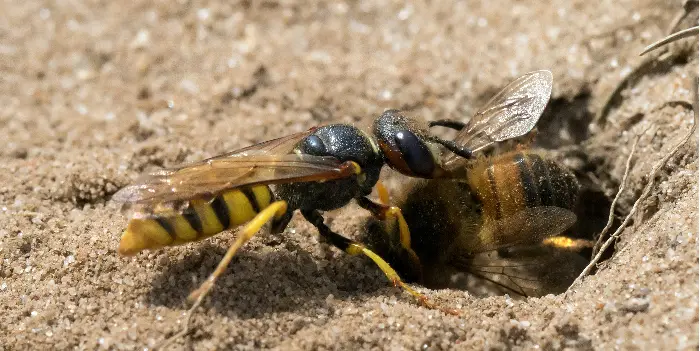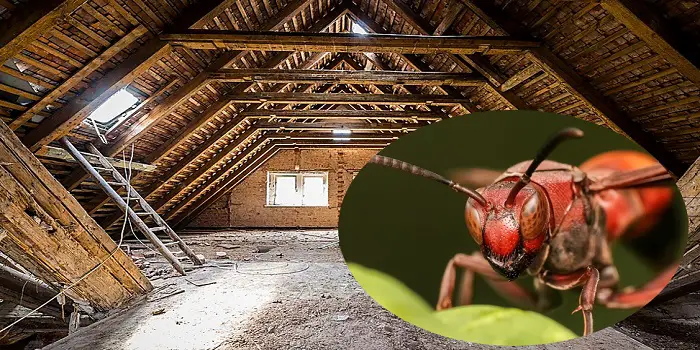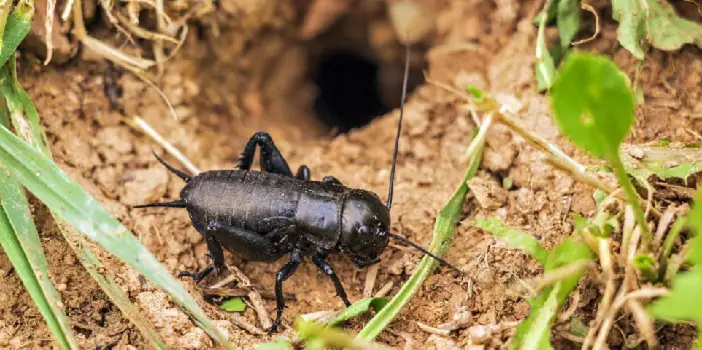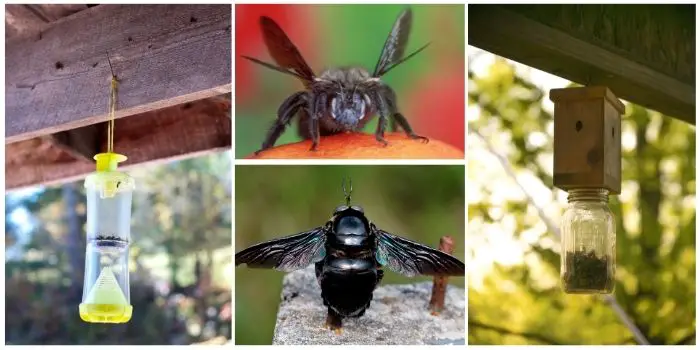
Carpenter bees look remarkably similar to bumblebees.
They are roughly the same size and shape with the only major difference being their hindquarters.
While a bumblebee will have a yellow stripe, a carpenter bee will have a primarily black hind area.
While the physical and coloring difference is subtle, one attribute of a carpenter bee is unique.
A carpenter bee will burrow into wood to make a home.
Unfortunately for many homeowners, the wood they choose is often the overhang of the roof or the framing of a window or door made from wood that they can burrow into.
The good thing is you can trap them in a uniquely designed device (often known as a carpenter bee trap).
The beauty of the carpenter bee trap is it works so well that you can catch many of them pretty soon if you can learn how to make one and how to use them correctly.
Below I will tell you more about this trap, how it works, and where you should place them for getting success.
Let’s start with why you need to use these traps in the first place…
Carpenter Bee Damage
Carpenter bees will act aggressively when you get near their homes.
But since they have no stingers and do not bite, they present no danger to you or your pets.
For the most part, carpenter bees look for food or hang around their homes.
You will often see them just after dawn and before dusk near the holes they have created.
During the winter, carpenter bees go into hibernation and remain well up in their holes for protection.
Once the weather warms up, they fly out and find mates during mating season.
It is then that they either return to the holes they have made or create new holes if they have traveled some distance.
Although they have difficulty with harder woods, the softwood often used on the outside of houses makes for the perfect home.
That is why many homeowners have turned to create traps for carpenter bees to limit the damage to their properties.

What is a Carpenter Bee Trap?
Unlike other bees, carpenter bees are not much attracted to sugary drinks and baits.
They also do not like to feed on wood.
But they are in regular search of new homes or wooden structures.
This makes the specifically designed bee traps an ideal way to attract them.
The only risk for using these carpenter bee traps is you are exposed to the stinging of bees when you use them in your backyard or garden.
So, it’s recommended to use a bee suit and avoid getting in contact with the bees if you are allergic.
What does a carpenter bee trap look like?
If you have seen a carpenter bee trap, the most common versions look similar in shape and size to a birdhouse.
They tend to be shaped roughly like houses and even have a roof of sorts.
This is not meant to fool the carpenter bees, but it is more of a practical feature when hanging them in suitable locations.
The trap itself is relatively simple but brilliant in its approach because it uses the very instincts of the carpenter bee to get itself trapped.
The base of the trap is created from softwood, the perfect type of wood for a carpenter bee to use to make its shelter.
The wood base has holes that are drilled upwards towards the top. The diameter of the holes is quite similar to what a carpenter bee will create.
Because the holes are angled upward, it means that the light will not reach very far into the hole, which is quite important.
The top of the trap is solid, durable plastic designed to withstand the sun’s elements and UV rays. This also protects the wood to a certain degree.
This means the trap will work yearly in trapping carpenter bees.
How exactly the trap works is simplicity itself.
How Does a Carpenter Bee Trap Work?
The trap mimics the homes carpenter bees make in the wood. The brilliance of the trap is the light source.
Once a carpenter bee enters one of the angled holes, its body cuts off the light from behind it.
This means that the only source of light comes from the front.
At the front is a hole that leads down to a plastic container.
Once the carpenter bee moves into the container, they are trapped.
They cannot get back out again because the container prevents them from returning through the holes in which they entered.
This is because carpenter bees will instinctively fly towards the light.
And since the hole they exited into the container is dark, they will simply buzz around the container itself and not know to fly upwards back into the hole.
It helps that the container is made from a plastic slick enough to prevent the carpenter bees from simply walking up the sides.
Plus, the hole at the top is the end of a funnel which makes it virtually impossible for them to fly directly upwards.
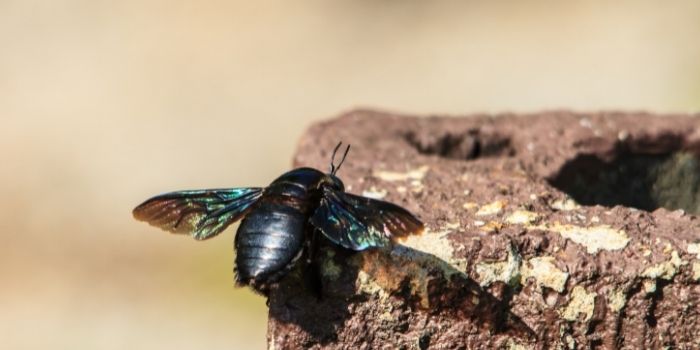
What is the Best Carpenter Bee Trap On the Market?
I have tried Carpenter Bee Traps by CBS and Mac’s LLC.
Out of all the models available on the market to buy, CBS Carpenter Bee Trap is very easy to use, and I really like the way it works.
At first glance, it may seem like a birdhouse, but it’s not.
Its sturdy construction and patent design are meant to capture and hold tons of bees at a time without allowing them to escape when they are in.
Best Features:
- Attract different types of bees
- Comes with a glass mason jar
- Made from durable treated cedar wood
- Appears to be a nesting location for bees
- Can handle different types of weather conditions
Do These Traps Need Bait? – Where to Put Them?
This type of trap does not need any bait because the hole itself attracts the carpenter bees, and they are not searching for any food.
If you want to bait the trap to get the bees attracted fast, you can place a dead carpenter bee in the bottom receptacle of the trap, which will work to attract the bees.
Once the bee gets trapped in the container, they will usually pass away by starving to death.
Carpenter bees need a considerable amount of food to survive, so the lack of food means they will be dead in a relatively short time.
Plus, the dead bees will release a pheromone that will attract even more bees to the trap.
This is because carpenter bees will release this pheromone once they find and create their home, so they can find it again next year.
However, you can add bee bait to the bottom of the container if you want to bring in more carpenter bees.
While it is not necessary, it can help remove many of them if they are around your home.
Plus, if you want to release the bees and not let them die in the traps, the bait will be more useful in the long run.
Right Placement Is Important As Well
You should put the traps on the sunny side of your home.
Carpenter bees love the warmth, so set up each trap about fifteen feet apart if you are experiencing a swarm of carpenter bees.
Set up the traps and eliminate the holes they have created in your home by filling them with putty cork, plugs, or caulking compounds.
The Conclusion
The carpenter bee traps simply provide a convenient nesting site for the bees.
However, to make these DIY wooden block traps work as desired, you need to destroy their original nest.
This will encourage the bees to find another safe place to live.
Keep in mind that carpenter bees and wood bees are the same species of bee.
They will both react the same to the carpenter bee trap.
You need not do anything else once you set up the trap. Occasionally, you will want to dump the dead bees out of the trap.
Or, if you want to release the bees, you’ll need to find a place well away from your home and in the woods preferably.

Welcome to ProShieldPest.com. I am Tina Jones. I have been working as a pest removal professional in Winslow, Arizona lately. At present, I love to spend my time with my family as a retiree.
Here I share all my knowledge and experiences to help people understand better how they can stop pests at their homes without actually killing them. Hopefully, the information you will find here will help in safeguarding your home! You can check more about me here.


